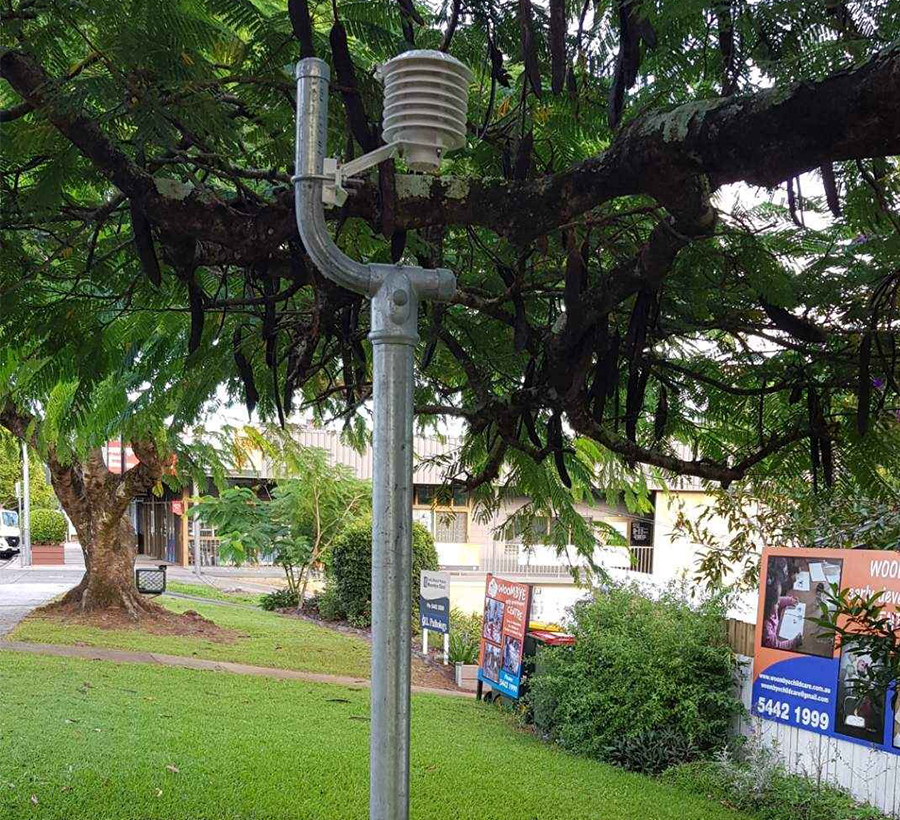Sunshine Coast Council is turning to remote sensors and the ‘Internet of Things’ to get more in touch with what its communities need from it, and to run more efficiently.
Real-time data on people movement, water usage and ambient temperatures is now being captured in Woombye to help Sunshine Coast Council improve its delivery of services and facilities into the future.
The Data Driven Decision Making (DDDM) pilot project, which is part of Council’s Smart City Framework, is capturing information about pedestrian and vehicle movement in the area, including time spent in the area and direction of movement.

A sensor in Woombye that is collecting data for Council
Twenty car parking bay sensors have been installed to capture data about how many vehicles use parking bays, how long they stay, and the peak times.
Division 5 Councillor Winston Johnston said capturing real-time data is becoming increasingly important to Council, as it provides definitive information showing how Council can improve the way it plans for the future, and deliver more efficient services and infrastructure for the Sunshine Coast community.
“A networked water meter is also providing council with data on things like how many people are using public amenities in Woombye, how much water is being used and if there are water leaks,” Cr Johnston said.
The data informs Council about the scheduling of maintenance and cleaning schedules, as well as identifying potential misuse of facilities. It also helps Council run these facilities in a more environmentally sustainable way.
A weather station and ambient temperature sensors have been installed to assist Council’s Disaster Management team in the short term, and assist with climate change policy over the longer term.
The ambient temperature sensor is one of four which, along with the movement and counting sensors, will provide a complete picture of the day-to-day and longer-term trends within the township of Woombye and support data-driven design for Council’s placemaking team.
“A thermal image camera is also providing council with data on temperature comparisons between asphalt, concrete, grass, canopy or shaded locations. This information will be used to improve planning and design of public areas, using materials and colours that provide cooler, more comfortable open spaces for our community,” Cr Johnston said.
Local businesses have welcomed the pilot, saying it will help tourists connect better with local communities.
Vice President of the Woombye Community & Business Association (WCBA), Grant Palethorpe, said the data on car parking would be of particular interest to support measures or solutions that can be put in place to ensure car parking is less of a problem into the future.
“The data collection on ambient versus pavement temperatures in this project will be compelling. If we want great public spaces, they need to be comfortable to be in,” Mr Palethorpe said.
“Improving walkability will also help to reduce reliance on cars and the issues that Woombye has with car parking.”
The Woombye pilot project is just one of many smart city projects being implemented by councils across the state to deliver sustainable, prosperous and inclusive futures for their communities.
Council’s Smart Centre and Living Lab showcases examples of Smart City technology at work. You can visit the Smart Centre Monday to Friday from 12pm–4pm or contact smartcity@sunshinecoast.qld.gov.au to organise a corporate booking.
Smart City projects being delivered by Sunshine Coast Council
• More than 200 free Wi-Fi access points across the region
• The SCC App, which provides easy and timely access to a variety of council services for local residents and visitors (guided walks, events around me, Disaster Hub, parking space availability, etc)
• The Ride to School Program, which uses sensors that send real-time notifications to parents about their child’s arrival and departure from school
• Public waste bin sensors that measure waste levels and send alerts if a bin is full or still empty to help Council deliver more cost-effective waste management services
• Networked street lighting turning on and off automatically during twilight periods, which reduces energy consumption, electricity costs, and CO2 emissions
• Pedestrian and cyclist counters monitor how many people use public areas, e.g. parks and walking trails, allowing council to better maintain and clean facilities
• Networked irrigation systems monitor soil moisture levels and send alerts if watering is required. Networked flow meters also identify problems and leaks early to help save unintended wastage.